How to Get Rid of 26 Different Types of Pond Weeds
Pond Academy is reader-supported. Buying through links on our site may earn us an affiliate commission. As an Amazon Associate I earn from qualifying purchases.
Are pond weeds taking over your pond?
Don't worry, you're not alone.
The goods news is that getting rid of pond weeds may be easier than you think... as long as you follow the right steps for the specific weeds or plants that are invading your pond.
Below is a handy guide of all the various types of pond weeds with pictures to help you identify the weeds in your pond.
And they are broken down by the different types of pond weeds - emergent, floating, and submerged - with tips on how to effectively get rid of each one for good!
Emergent Pond Weed Control
Emergent weeds are stiff-stemmed littoral plants whose upper reaches extend beyond the water’s surface. Their extensive root systems and regenerative ability can make them difficult to eliminate.
Here are the most common types of emergent weed, and the most effective natural and chemical ways to control them.
Alligator Weed

Alligator Weed is a creeping, fast-growing perennial whose stems form a dense cover, crowding out and shading other aquatic plants and in many cases impeding the flow of water to a pond from natural sources. Native to Paraguay and surrounding regions, Alligator Weed is considered an invasive species elsewhere.
Natural Control
- Alligator Weed can be easily cut down, especially before it has begun to overwhelm the shoreline. But this only constrains the plant, which regrows readily from stumps or roots.
Chemical Control
- The only way to truly eliminate Alligator Weed is to kill it at the roots using purpose-made herbicides, such as Pond Logic’s Shoreline Defense.
Bulrush

Bulrushes are towering rooted plants whose thin, grassy leaves can grow more than ten feet above the water’s surface. Nearly every part of bulrushes can be used as a food source—they are particularly high in vitamin K and manganese—but they can present problems to smaller ponds.
Natural Control
- Bulrushes propagate both through seed and below the ground, by way of rhizomes, which makes them especially difficult to dig out. Like peonies, bulrushes can regrow even if bits of rhizome escape destruction.
Chemical Control
- The only way to truly eliminate Bulrush is to kill it at the roots using broad-spectrum herbicides, such as Shoreline Defense.
Cattails

Cattails are closely related to bulrushes but grow slightly less tall. The distinctive cigar-like feature at the top of mature cattails is actually a dense matting of flowers; these produce seeds that can float on air or water for long distances, allowing cattails to spread quickly and persistently. Like bulrushes, they also spread through rhizomic growth.
Natural Control
- Like bulrushes, cattails can be cut down or their rhizomes dug out. Their ability to broadcast seeds, though, makes it difficult to completely eliminate cattails through natural means once they have established themselves in a pond. However, we do have an extensive guide on how to kill cattails in a pond naturally if they are really starting to become a problem.
Chemical Control
- The same systemic, broad-spectrum herbicides that control bulrushes, like Shoreline Defense, can be used to rid a pond of cattails once they have grown well clear of the water’s surface.
Water Primrose

Emergent varieties of Water Primrose present themselves as low-lying plants with small, thin leaves and small yellow flowers. Below the surface, though, they grow dense networks of runners that periodically form roots and re-anchor themselves in the soil. Water Primrose propagates both through its roots and by seed, which along with its propensity to grow quickly can easily make it a threat to ponds and small lakes. Its mat of runners provides ideal nesting grounds for mosquitos.
Natural Control
- Water primrose can be suppressed by cutting down emergent growth or digging plants up from the roots. Because their runners establish root systems themselves, which can spawn new growth, natural methods usually do not eliminate water primrose altogether.
Chemical Control
- Systemic herbicides like Shoreline Defense will kill water primrose at its roots, provided that the entire root system is treated.
Phragmites

Most ponds are surrounded in part by grassy areas, but Reed Grass, or Phragmites, is a special case. This invasive perennial can grow even taller than bulrushes, and far more aggressively. Its large rhizomes produce toxins that kill surrounding plants, and its dense undergrowth crowds them out.
For all its eagerness to dominate its habitat, Phragmites offers very little usable habitat for most species and is a poor source of food. Left unchecked, it can significantly lower water levels in ponds of any size, both through absorption and transpiration and by clogging natural sources of incoming water.
Chemical Control
- Systemic herbicides like Shoreline Defense are the only proven way to eliminate Phragmites.
Purple Loosestrife

Once prized as an ornamental plant, Purple Loosestrife is so adept at escaping containment that it is now illegal in many states and provinces surrounding the Great Lakes.
Each bushy plant can grow to six feet tall during the summer when it also grows tall clutches of red-and-purple flowers. It can quickly dominate the shores of ponds and small lakes, hindering access and driving out other aquatic plants. Its dense, woody growth provides poor habitat for aquatic life, and its extensive root systems can demand enough water to lower pond levels.
Natural Control
- Purple Loosestrife can be cut down or its rhizomes dug up, but its aggressive seed production and ability to grow from rhizome fragments mean that natural methods usually suppress its growth, rather than eliminating it altogether.
Chemical Control
- Systemic herbicides like Shoreline Defense will kill Purple Loosestrife at its roots, although seeds may remain in the pond.
Shoreline Grass

Grass is a common feature of pond sides, but some types of pond grass can become problematic, especially when they grow to seven or eight feet tall. Most grasses are spirited propagators, both through root growth and by seed.
Natural Control
- By their nature, grasses propagate aggressively, both through their rhizomes and by way of seeds, so natural methods such as mowing or even digging them up by the roots are often not completely effective.
Chemical Control
- Systemic herbicides, such as Shoreline Defense, will work to kill the root of the plant.
Smartweed

Smartweed, also known as Knotweed, is a catchall for hundreds of species of related plants. All have jointed stems, and most grow attractive pink or white flowers. Its name derives from the Old English ars-smerte, which speaks to its history as a treatment for afflictions of the posterior. Smartweed may grow well clear of the water’s surface or remain largely submerged, with only the flowers reaching the air.
Natural Control
- Smartweed can be cut down to ground level or the rhizomes dug up. Its root system tends to be extensive, and the plant can grow back from even a bit of root or rhizome left behind.
Chemical Control
- Systemic herbicides, such as Shoreline Defense, will work to kill Smartweed at the roots.
Get Our Best Pond Tips Sent to Your Inbox for Free!
Join thousands of others and learn from our decades of pond building and maintenance experience! Your pond will thank you!
By subscribing you agree to receive emails from PondAcademy.com. We will always respect your privacy and you can unsubscribe at any time.
Floating Pond Weed Control
While emergent plants tend to grow at the water’s edge, floating plant are naturally freer to affect the entire pond. Some floating plants are anchored to the pond’s floor by roots, but only develop foliage above the water’s surface. Others float completely freely with trailing root systems that absorb nutrients directly from the water. When floating plants grow too rampantly, they deprive a pond of sunlight and oxygen, drastically affecting its ecosystem.
Let's look at the most effective ways of clearing your pond of floating weeds.
Azolla

Azolla, also known as Fairy Moss or Mosquito Fern, is a small, fast-growing fern that floats freely on the water’s surface. Although each Azolla plant is less than two inches wide, they grow so quickly and closely together—even to the point of interlocking their leaves—that they can easily overwhelm a small pond or water garden.
Natural Control
- As with many free-floating pond weeds, Azolla can be raked or skimmed off the water’s surface with a pond rake (check out our homemade pond rake for an effective and affordable rake).
Chemical Control
- A broad-spectrum contact herbicide like Ultra Pond Weed Defense or Clipper is the surest way to kill established Azolla, though owners should monitor the pond for new growth.
Duckweed
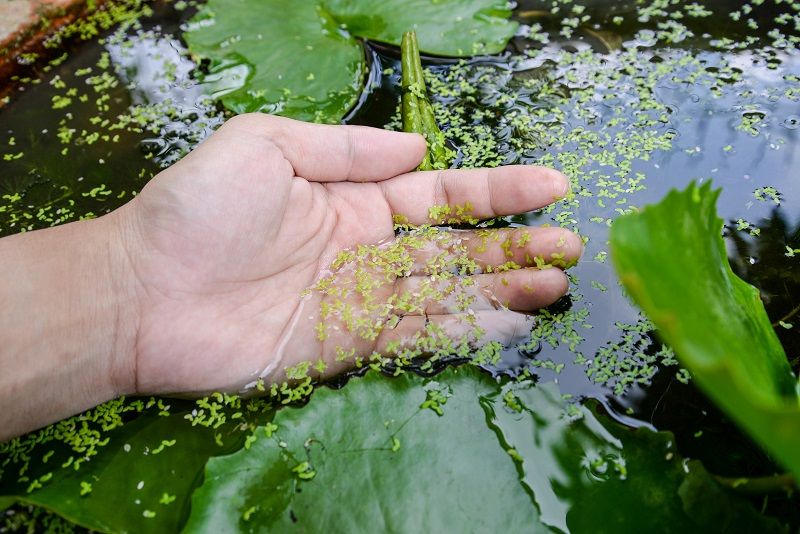
Duckweed (lemnoideae) is much smaller even than Azolla and grows so densely that it is confused for pond scum. Its size makes it especially dangerous: while larger floating plants like lilies often cannot grow so closely together that they completely block out the sun, Duckweed forms a dense mat and can cover every square inch of a pond if left untreated.
Natural Control
- Duckweed can be skimmed or raked from the pond’s surface with a heavy-duty pond rake.
- Because it is so small, Duckweed thrives in stagnant water. A pond aeration system can keep the water moving too quickly for Duckweed to take hold while leaving other life undisturbed.
- Check out our duckweed control article for more tips to naturally get rid of duckweed.
Chemical Control
- A broad-spectrum contact herbicide like Ultra Pond Weed Defense or Clipper will kill Duckweed but may be inconvenient to apply due to having to reapply often, especially in larger ponds.
- Whole-pond treatments like Pond Logic Wipe Out are designed to keep Duckweed and other nuisances at bay for months at a time.
Spatterdock
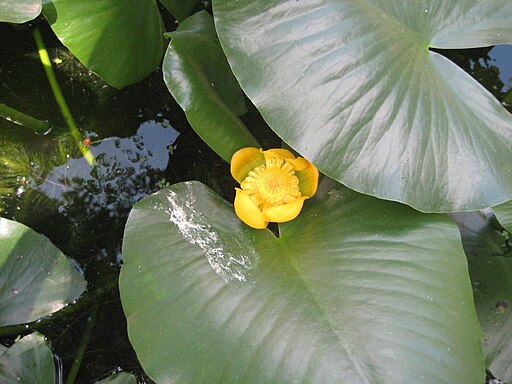
Spatterdock, or Cow Lily, is a rooted perennial whose entire complement of foliage lives above the water. Because it relies entirely on above-water greenery, its leaves are relatively large, reaching up to 18 inches long and 10 inches wide.
Just a handful of Spatterdock plants can affect the ecosystem of a small pond. Because it propagates both through rhizomes and by way of seed, Spatterdock can be difficult to remove entirely.
Natural Control
- Spatterdock can easily be cut down, but digging out its rhizomes is a more difficult task. Because it also propagates from seed, manual control of Spatterdock is usually not completely effective.
Chemical Control
There are several options to control Spatterdock in ponds:
- Whole-pond treatment options like Pond Logic Wipe Out are designed to keep Spatterdock and other nuisances at bay for months at a time.
- Systemic herbicides like Shoreline Defense will kill Spatterdock at its roots, provided that the entire root system is treated.
- Because Spatterdock grows near the shoreline, broad-spectrum contact herbicides like Ultra Pond Weed Defense or Clipper are popular options.
Water Hyacinth
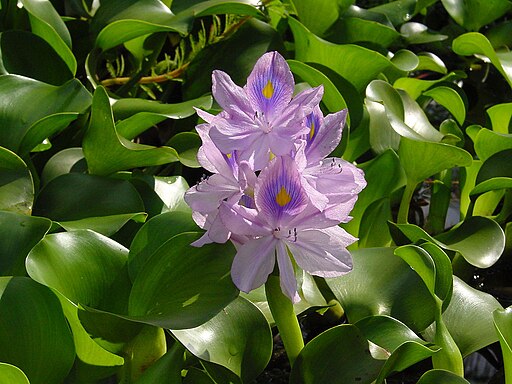
Water Hyacinth can grow up to three feet above the pond’s surface. Below the surface, it grows such a dense network of trailing roots that an acre’s worth of Water Hyacinth can weigh more than 200 tons. Their root systems allow Water Hyacinths to grow very closely together, and their broad foliage can completely block sunlight from reaching the rest of the pond. Water Hyacinth propagates extremely rapidly, both through runners and by seed.
Natural Control
- Because its root system floats freely, Water Hyacinth can be raked or skimmed off a pond’s surface with a heavy-duty pond rake.
Chemical Control
- Systemic herbicides like Shoreline Defense will kill Water Hyacinth at its roots.
- Broad-spectrum contact herbicides like Ultra Pond Weed Defense or Clipper are effective against Water Hyacinth, though plants floating away from shore may be difficult to reach.
Water Lettuce

Let’s get this out of the way first: water lettuce is not edible. Nor is it lettuce. Water Lettuce gets its name from its thick, broad leaves, which can grow up to a foot in length.
Like Water Hyacinth, Water Lettuce is a popular ornamental plant that in small quantities can benefit a pond by helping clarify the water. Our How to Plant Water lettuce in a Pond guide is very popular for this reason!
Its aggressive growth, however, and ability to completely block the sun mean that Water Lettuce can quickly outgrow its usefulness and become a nuisance.
Natural Control
- Because its root system floats freely, Water Lettuce can be raked or skimmed off a pond’s surface with a heavy-duty pond rake.
Chemical Control
- Systemic herbicides like Shoreline Defense will kill Water Lettuce at its roots.
- Broad-spectrum contact herbicides like Ultra Pond Weed Defense are effective against Water Lettuce, though plants floating away from shore may be difficult to reach.
- Clipper, a relatively new herbicide, is powerful enough to control fast-propagating invasive species like Water Lettuce and claims to be highly selective.
Water Lilly

Water Lillies are sought-after ornamental plants with beautiful flowers. Some pond owners go to great lengths to encourage their growth, rather than treating them as nuisances. In the right conditions, though—plenty of still, shallow water, and a pond floor that encourages the growth of rootstocks—Water Lillies can grow beyond their usefulness. Their large floating leaves often grow to nearly a foot long, opening to their full length at dawn and remaining open until early afternoon. When they overcrowd a pond, the shade they cast may upset the pond’s ecosystem.
Natural Control
- Water Lillies can be cut down to ground level or the rhizomes dug up. This method tends to leave some rhizomes behind, and since Water Lillies also propagate by seed, it is usually not completely effective.
Chemical Control
- Whole-pond treatments like Pond Logic Wipe Out are designed to keep unchecked Water Lillies and other nuisances at bay for months at a time.
- Systemic herbicides like Shoreline Defense will kill Water Lillies at their roots, provided that the entire root system is treated.
- Because Water Lillies prefer shallow water, broad-spectrum contact herbicides like Ultra Pond Weed Defense or Clipper are popular options for culling unwanted plants.
To learn more, check out our full guide on how to get rid of lily pads in a pond.
Watershield

Watershield, or Dollar Bonnet, takes its name for the shape of its floating leaves. At first glance, Watershields resemble small lilies, even down to the shallow water it prefers. But there are some significant differences.
Most of the submerged parts of the plant are covered in a protective jelly-like substance, which only partially prevents fish, waterfowl, and small invertebrates from nibbling away at the nutritious leaves and stems. Water Shield is even healthy for humans to eat. Those benefits are offset by the plant’s rapid propagation and tendency to cast unwanted degrees of shade.
Natural Control
- Watershield can be cut down to ground level or the rhizomes dug up. This method tends to leave some rhizomes behind, and since Watershield also propagates by seed, it is usually not completely effective.
Chemical Control
- Systemic herbicides like Shoreline Defense will kill Watershield at its roots, provided that the entire root system is treated.
- Because Watershield prefers shallow water, broad-spectrum contact herbicides like Ultra Pond Weed Defense or Clipper are popular options.
Watermeal

Watermeal is the world’s smallest seed-bearing plant: it takes its name from the grainy, cornmeal-like texture it gives to ponds when it takes over. Which it will if given the chance. Watermeal propagates extremely aggressively, often in tandem with other small floating plants like Duckweed and Azolla.
Natural Control
- Watermeal can be skimmed or raked from the pond’s surface with a heavy-duty pond rake.
- Because it is so small, watermeal thrives in stagnant water. A pond aeration system can keep the water moving too quickly for Watermeal to take hold while leaving other life undisturbed.
Chemical Control
- A broad-spectrum contact herbicide like Ultra Pond Weed Defense or Clipper is the surest way to kill established Watermeal, though owners should monitor the pond for new growth.
Submerged Pond Weed Control
Submerged plants grow largely or entirely below the pond’s surface. Some may develop growth above the waterline, but in all cases, the majority of a submerged plant’s growth occurs in the water. Their stems tend to be soft and yielding, which allows them to withstand currents and disturbances in the water without breaking.
American Pondweed

Although it is classified as a submerged plant, American Pondweed produces its heaviest concentration of foliage above the water’s surface, where it presents some of the same dangers as emergent and floating plants.
Its emergent leaves are generally six inches long and two inches wide and spread far from the plant’s main stem. Its leaves and red-brown flowers are good food sources for fish and waterfowl, and its submerged portions offer a decent, if not ideal, habitat for aquatic life.
Pondweed’s main detriments to ponds are its ability to partially shade large portions of the water, and its tendency to crowd out more beneficial plants.
Natural Control
- American Pondweed is easily cut, after which it can be raked from the pond’s surface with a heavy-duty pond rake. Because it grows both from seed and from rhizomes, cutting and raking only controls Pondweed, and does little to prevent its return.
Chemical Control
- Broad-spectrum contact herbicides like Ultra Pond Weed Defense are effective against American Pondweed, though plants floating away from shore may be difficult to reach.
- Clipper is powerful enough to control American Pondweed and claims to be highly selective.
Bladderwort
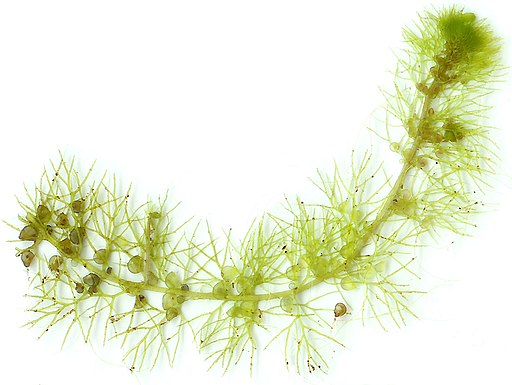
Bladderwort does not propagate as aggressively as some other pond or lake weeds, but it might be the fastest plant in the world. A free-floating carnivorous plant that lives mostly submersed underwater, Bladderwort traps tiny organisms in the miniscule bladders that line its stem-like structure. Hairs surrounding the bladder register the presence of prey as it brushes past, and the bladder flashes open and then closes to grab a meal.
“Bladderwort” is actually a genus comprising more than 200 species. Some grow more than a foot long, but most grow to a few inches. All grow in or near calm bodies of freshwater. Their yellow, Snapdragon-like flowers are pleasant, but Bladderwort grows quickly enough and becomes easily enough enmeshed with other pond weeds that it can contribute to an unhealthy covering of a pond’s surface.
Natural Control
- Bladderwort can be raked or skimmed from a pond with a heavy-duty pond rake.
Chemical Control
- Whole-pond treatments like Pond Logic Wipe Out can clear a pond of Bladderwort and other water weeds for an entire season.
- Broad-spectrum contact herbicides like Ultra Pond Weed Defense or Clipper can quickly kill Bladderwort.
Clasping Leaf
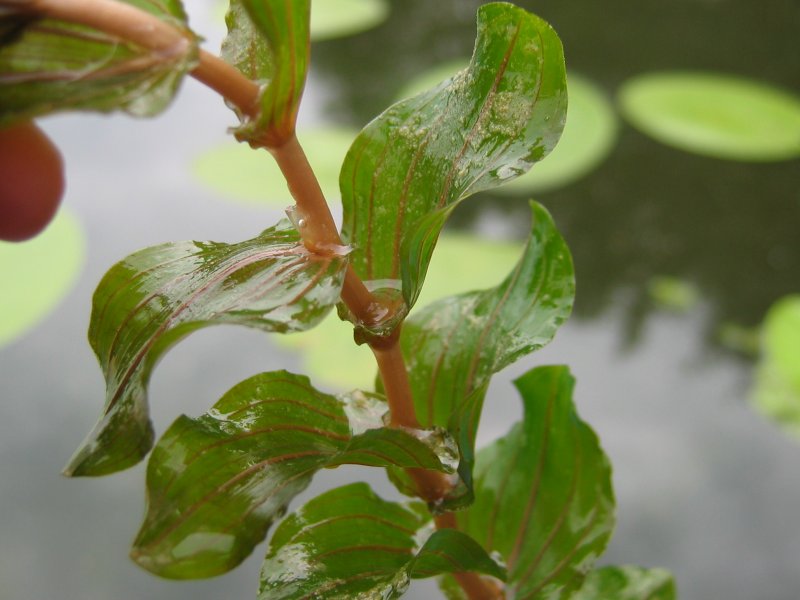
Clasping Leaf Pondweed lives more completely underwater than many other submerged pond weeds, relying more heavily than others on broad leaves that efficiently photosynthesize glucose from the sunlight available to them underwater.
Although it offers value both as a food source and as a habitat for aquatic life, Clasping Leaf can grow so densely that other plants are crowded out, and can cast damaging amounts of shade.
Natural Control
- Clasping Leaf can be cut down, but it grows so readily from rhizomes that this is only a temporary solution.
- Pond dye offers a sort of sunscreen for the entire pond, limiting the opportunity of entirely submerged plants like Clasping Leaf to generate enough food through photosynthesis.
Chemical Control
- A broad-spectrum contact herbicide like Ultra Pond Weed Defense or Clipper will kill Clasping Leaf but may be inconvenient to apply (and re-apply), especially in larger ponds.
- Whole-pond treatments like Pond Logic Wipe Out are designed to keep Clasping Leaf and other densely growing weeds at bay for months at a time.
Coontail

Coontail, or Hornwort, is a submerged oxygenating pond plant that has earned great popularity in aquariums. In that context, it is easy to maintain and provides a terrific habitat for eggs, small pond fish, and tiny invertebrates.
In the wild, though, Coontail can grow quickly and create dense beds that drive out other plant species. In those cases, it also prevents other plants from receiving adequate sunlight. Coontail consumes a great deal of nitrogen and secretes chemicals that may inhibit the growth of phytoplankton.
Natural Control
- Coontail can be cut down, but it grows readily from any seeds that remain.
- Pond dye offers a sort of sunscreen for the entire pond, limiting the opportunity of entirely submerged plants like Coontail to generate enough food through photosynthesis.
Chemical Control
- Whole-pond treatments like Pond Logic Wipe Out are designed to keep rampant Coontail and other nuisances at bay for months at a time.
- Broad-spectrum contact herbicides like Ultra Pond Weed Defense are popular options for culling overgrown Coontail.
- Clipper may be especially useful against Coontail.
Curly Leaf Pondweed
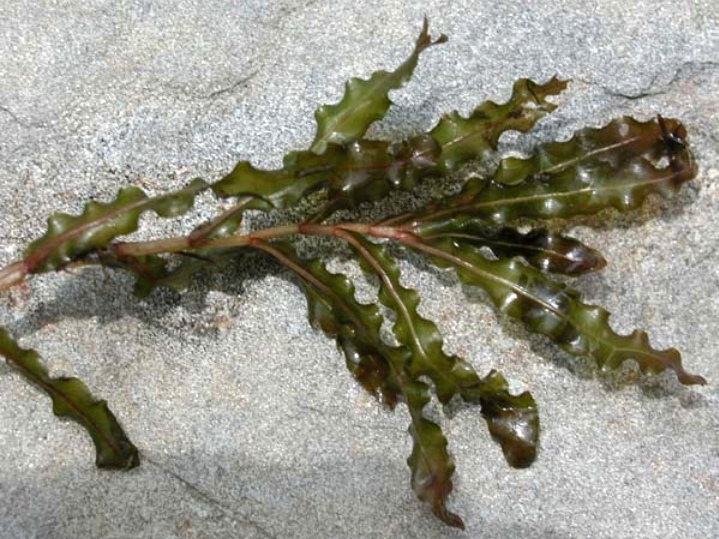
Often confused with Clasping Leaf, Curly Leaf Pondweed grows aggressively and creates dense mats on the pond’s floor. It can easily grow so thickly that it displaces other, more beneficial plants: Curly Leaf Pondweed does not provide much of a habitat for aquatic life. It is a fantastically hardy plant, able to thrive in flowing water and in ecosystems overwhelmed by excessive nutrients.
Natural Control
- Curly Leaf Pondweed can be cut down, but it grows so readily from roots and seeds that this is only a temporary solution.
- Pond dye offers a sort of sunscreen for the entire pond, limiting the opportunity of entirely submerged plants like Curly Leaf Pondweed to generate enough food through photosynthesis.
Chemical Control
- Whole-pond treatments like Pond Logic Wipe Out are designed to keep Curly Leaf Pondweed and other densely growing weeds at bay for months at a time.
- A broad-spectrum contact herbicide like Ultra Pond Weed Defense will kill Curly Leaf Pondweed but may be inconvenient to apply, especially in larger ponds.
- Clipper may be especially useful against Curly Leaf Pondweed.
Eurasian Watermilfoil

Not all Watermilfoil species propagate aggressively enough to qualify as nuisances, but the Eurasian species (myriophyllum spicatum) certainly does. While its feathery leaves provide good habitat for aquatic life, Eurasian Watermilfoil’s ability to spawn new roots from dislodged fragments of a healthy plant speaks to its ability to quickly dominate its part of a pond, where it crowds out other species.
Natural Control
- Eurasian Watermilfoil can be cut down, but this will almost certainly leave fragments to fall to the pond floor and develop new roots.
- Pond dye offers a sort of sunscreen for the entire pond, limiting the opportunity of submerged plants like Eurasian Watermilfoil to generate enough food through photosynthesis.
Chemical Control
- Whole-pond treatments like Pond Logic Wipe Out are designed to keep Eurasian Watermilfoil and other densely growing weeds at bay for months at a time.
- A broad-spectrum contact herbicide like Ultra Pond Weed Defense will kill Eurasian Watermilfoil but may be inconvenient to apply, especially in larger ponds.
- Clipper may be especially useful against Eurasian Watermilfoil.
Hydrilla/Elodea

Hydrilla can live as an entirely submerged plant, but in all but the deepest ponds, it reaches the surface, where it develops thick mats of vegetation. It is highly aggressive, propagating by the usual rhizomes and seeds but also capable of reproducing by fragmentation and by releasing turions onto the pond’s floor. Hydrilla’s submerged leaves are small, usually less than half an inch long, so it provides very little cover for smaller aquatic life.
Natural Control
- Hydrilla can be cut down, but this will almost certainly leave fragments to fall to the pond floor and develop new roots.
- Pond dye offers a sort of sunscreen for the entire pond, limiting the opportunity of submerged plants like Hydrilla to generate enough food through photosynthesis.
Chemical Control
- Whole-pond treatments like Pond Logic Wipe Out are designed to keep Hydrilla and other densely growing weeds at bay for months at a time.
- A broad-spectrum contact herbicide like Ultra Pond Weed Defense will kill Hydrilla but may be inconvenient to apply, especially in larger ponds.
- Clipper may be especially useful against Hydrilla.
Southern Naiad

Southern Naiad is a completely submerged, somewhat spindly plant with thin leaves growing up to an inch and a half. It gets its other common name, Bushy Pondweed, from the dense, almost fibrous mats of vegetation that form when it is allowed to grow unchecked. This creates an ideal habitat for small aquatic organisms and a valuable food source for ducks and other waterfowl. Southern Naiad can become problematic, though, when its sheer density and sun-blocking ability crowd out other desirable pond plants.
Natural Control
- Southern Naiad can be cut back with some difficulty but will regrow.
- Pond dye limits the opportunity of submerged plants like Southern Naiad to generate enough food through photosynthesis.
Chemical Control
- Whole-pond treatments like Pond Logic Wipe Out are designed to keep Southern Naiad and other densely growing weeds at bay for months at a time.
- A broad-spectrum contact herbicide like Ultra Pond Weed Defense will kill Southern Naiad but may be inconvenient to apply, especially in larger ponds.
- Clipper may be especially useful against Southern Naiad.
Parrots Feather

Parrots Feather is a rooted, fast-growing weed of the milfoil family capable of growing more than 12 feet tall in the right circumstances. Its feathery leaves are bunched in groups of six, each of which is divided into dozens of smaller leaflets; this gives Parrots Feather its distinctive shape.
Parrots Feather provides a valuable habitat for small pond creatures, but its aggressiveness tends to drive away other beneficial species. It is a terrific propagator, able to reproduce through its roots and seeds and also by growing new roots from runners and dislodged nodes. On the pond floor, it creates a dense mat of roots and stolons that can prevent the seeds and roots of other plants from establishing themselves.
Natural Control
- Parrots Feather can be cut back with some difficulty but will regrow.
- As with most fully submerged aquatic weeds, pond dye limits the opportunity of Parrots Feather to generate enough food through photosynthesis.
Chemical Control
- Parrots Feather requires strong, focused treatment; a highly selective herbicide like Reward is the wisest choice.
Sago Pondweed

Sago Pondweed is a submerged grass that represents an important food source for waterfowl and larger aquatic organisms, and an ideal habitat for smaller animals. This particular type of underwater pond grass grows in dense, bushy clusters, and like most grasses propagates aggressively via rhizomes and seeds.
Like many submerged plants, Sago Pondweed is highly beneficial until it seizes too much territory. It may crowd out other beneficial species, and if it grows beyond its usefulness as a food source may create overloads of dead vegetation that attract harmful bacteria and algae.
Natural Control
- Sago Pondweed can be cut back with some difficulty but will regrow.
- As with most fully submerged weeds, pond dye limits the opportunity of Sago Pondweed to generate enough food through photosynthesis.
Chemical Control
- Whole-pond treatments like Pond Logic Wipe Out are designed to keep Sago Pondweed and other densely growing weeds at bay for months at a time.
- A broad-spectrum contact herbicide like Ultra Pond Weed Defense will kill Sago Pondweed but may be inconvenient to apply, especially in larger ponds.
- Clipper may be especially useful against Sago Pondweed.
Recommended Control Products
Here's a quick list of the products I mentioned above to control pond weeds. Only use the product that's recommended for the type of pond weed you are trying to control. And always follow the manufacturer's instructions.
Airmax Shoreline Defense Aquatic Herbicide

Alright, let's talk about Shoreline Defense. This product is essentially aimed at dealing with emergent aquatic weeds and grasses, like cattails, which can be quite a nuisance around pond shorelines.
The way Shoreline Defense works is pretty straightforward. You apply it directly to the foliage of the target weeds. This method ensures that the herbicide is absorbed by the plant and reaches the roots. It's this action on the roots that gives the product its long-term control capability. That's important because simply cutting back these types of plants often isn't enough; they tend to grow back if the roots aren't dealt with.
It's worth noting, though, that Shoreline Defense isn't suitable for all types of aquatic weeds. It's specifically not meant for submerged weeds. So, if you're dealing with those, I would use Ultra Pondweed Defense or Wipeout
Timing is also key when using Shoreline Defense. It should be applied when the target weeds are actively growing. This is because the active ingredients in the product need to be absorbed by the plant in order to be effective. This absorption process is what allows the herbicide to travel down to the roots and destroy the entire plant.
Airmax Ultra Pondweed Defense Aquatic Herbicide

This product is pretty versatile in terms of the types of pond weeds it can handle. It's designed to work on a range of them, including submerged, floating, and emergent weeds. This makes it a more all-encompassing solution compared to something like Shoreline Defense, which is more focused on emergent weeds.
One of the interesting points about Ultra Pondweed Defense is its ability to control Duckweed in slow-moving water. Duckweed can be particularly challenging to manage, so having a product that can tackle it effectively is a big plus. However, it's described as a short-term control solution, so that's something to keep in mind.
Now, when it comes to application, consistency is key. The recommendation is to use it with Treatment Booster Plus throughout the growing season for the best results. This is especially true for early-season emergent treatments, which might need more than one application to be effective.
But, there are some important restrictions to note. After applying Ultra Pondweed Defense, there's a waiting period before the water can be used again for certain purposes. It's a 3-day wait for human drinking water and a 1-day wait for consumption by livestock or domestic animals. These restrictions are important for safety and should be strictly adhered to.
Clipper Aquatic Herbicide

Clipper first caught my eye for its ability to quickly and selectively tackle some pretty tough aquatic plants. We're talking about nuisances like cabomba, watermeal, and even Eurasian watermilfoil, etc.
Now, when it comes to using this product, I appreciate that it's user-friendly. Mixing, handling, and measuring it seems pretty straightforward, which is great for someone like me who prefers hassle-free solutions. Seeing results fast is always a bonus, and that's something Clipper has delivered so far. But, of course, you've got to use it correctly. Following the instructions is key to getting those good results.
Airmax Wipeout Pond Weed Defense

WipeOut Pond Weed Defense is a really effective option for all-season aquatic weed control. It can handle both submerged and floating weeds, like duckweed, water lilies, coontail, fanwort, and watermilfoil. It's always a challenge to find something that works on a variety of weed types, so this versatility is a big deal for me.
What I really appreciate about WipeOut is the lack of restrictions. You don't have to worry about temperature or whether it's safe for swimming, boating, or even livestock. This makes it super convenient, especially if you're dealing with a pond that's used for multiple purposes. The application process is straightforward, too - just shake it, mix with water, and pour around the pond's edge. I like that simplicity.
However, patience is key with this one. It might take 30-60 days to see control over established weeds, and up to 90 days for full protection. Remember to apply it early in the season, right at the first sign of weed growth.
In my view, WipeOut Pond Weed Defense could be a great solution if you're looking for a versatile, easy-to-use herbicide without a bunch of restrictions. Just keep in mind that it's more of a long-term solution, so don't expect instant results.
Lake and Pond Dye

Pond Dye is an interesting and chemical-free approach to managing weed growth in ponds. It focuses on prevention rather than direct elimination. By adding color to the water, pond dye reduces sunlight penetration. Less sunlight means slower weed growth, which can be a real game-changer if you're trying to keep weeds at bay without resorting to chemicals.
Another aspect of pond dye that I find really appealing is its safety profile. It's safe for fish and wildlife, which is a big plus in my book. When you're dealing with a natural pond ecosystem, maintaining that balance is important. You don't want to solve one problem (like weed growth) only to create another (like harming the fish or other wildlife that call your pond home).
Using pond dye feels like a more holistic approach to pond management. It's not just about getting rid of weeds; it's about doing it in a way that's harmonious with the rest of the pond's ecosystem. And let's not forget, it can also enhance the aesthetic appeal of your pond, giving it a beautiful, natural-looking color.
Chemical Use Best Practices
The most effective means of weed control mentioned here tend to involve the use of chemical herbicides. Along with the manufacturer’s instructions, pond owners should follow a few broad rules of thumb whenever applying chemicals.
- First, proper pond weed identification is crucial to ensure you're applying the right strategy for removal. What works to remove one aquatic weed might not work for another.
- Treat the pond proactively, through a balance of beneficial plants and applications of beneficial bacteria like those found in PondClear and MuckAway, and even the natural shade provided by pond dye. These approaches are far gentler on ponds than even the most carefully formulated herbicides, and can greatly inhibit the ability of weeds to grow out of control.
- Use herbicides on no more than half the pond at one time, even less during times of rapid weed growth. Excessive weed growth places other aquatic life under stress, and herbicides can temporarily increase that stress, especially when added in large doses to every corner of a pond.
- After weeds have been killed off, be sure to remove as much dead vegetation as possible. While some weeds provide food to desired forms of aquatic life, dead vegetation primarily feeds harmful forms of algae.




